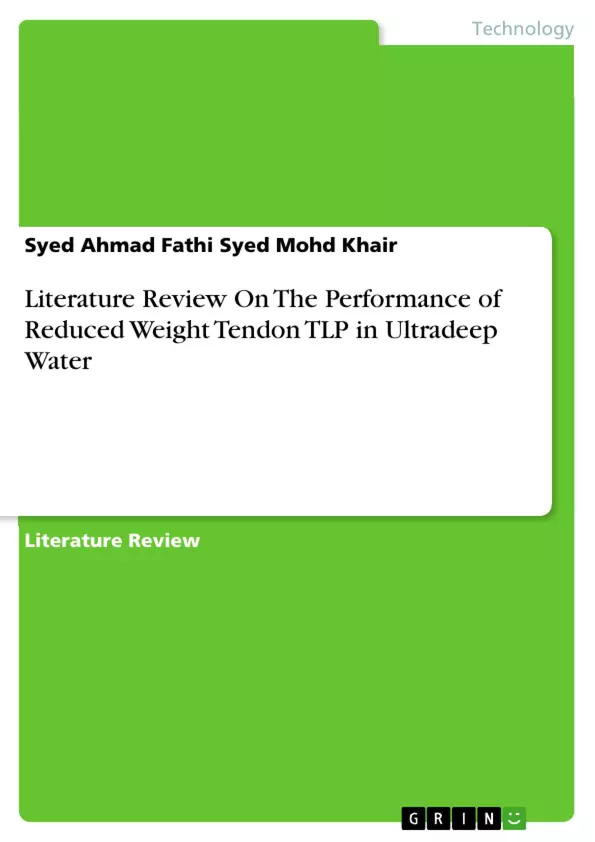The fast growing offshore industry has come up with advanced technology that makes it possible to produce oil and gas on deeper offshore sites. One of the interests now is to look for a structure and systems that are reliable and cost effective for ultra deep water operation. Tension leg platform (TLP) concept is currently been viewed for this ultra deepwater operation. TLP differ from other type of floating platform in a sense that the hull buoyancy exceed its weight, the hull is vertically moored at a draft below the displacement thus creating constant tension in the mooring line. The problem for the development of TLP beyond 1500 meters water depth is the material for the tendon. Conventional tendon made by steel is too heavy and proven to be unpractical in ultra deep water. New material is needed, that is lightweight and stiffer, and this material needs to meet the structural performance characteristic for practical development. This research is intended to demonstrate the performance of reduced weight tendons in ultra-deep water. The effect of weight reduction on motion response of the TLPs in regular and irregular waves and the performance differences between conventional tendons and reduced weight tendons in term of motion response also will be investigated. Based on the review it is known and widely accepted that numerical analysis is the most practical and economical way to analyze the structure, but because of the simplification and assumption of the numerical calculation a validation is needed. The numerical analysis will be done using industrial accepted software, ANSYS AQWA. For the purpose of validation, model test is proposed to be done in the test basin, but due to very limited water depth in the test basin, truncation method will be used instead of common traditional test. This method also known as hybrid method that uses numerical calculation to predict the cut off portion of the tether lines and using physical model test in the upper portion.
Inhaltsverzeichnis (Table of Contents)
- Abstract
- Introduction
- Environmental loads
- TLP tether system
Zielsetzung und Themenschwerpunkte (Objectives and Key Themes)
This research aims to demonstrate the performance of reduced weight tendons in ultra-deep water. It investigates the effect of weight reduction on the motion response of Tension Leg Platforms (TLPs) in regular and irregular waves, and compares the performance of conventional and reduced weight tendons. The research focuses on validating numerical analysis using industrial software (ANSYS AQWA) through model testing, particularly using the truncation method for deeper water conditions.
- Performance of reduced weight tendons in ultra-deep water
- Effect of weight reduction on TLP motion response
- Validation of numerical analysis using model testing
- Environmental loads on TLPs (waves, wind, current, extreme cases)
- TLP tether system design and performance (fatigue, reliability, stability)
Zusammenfassung der Kapitel (Chapter Summaries)
Introduction
This chapter provides an overview of the research topic and the significance of understanding the motion of offshore structures. It discusses the history of TLP development, the various factors influencing TLP design and operation, and the importance of analyzing environmental loads and tether integrity. The chapter also introduces the analytical approaches used in TLP research, including numerical modeling and model testing.
Environmental loads
This chapter focuses on the environmental forces that act on TLPs, including waves, wind, tides, and currents. It reviews studies that investigate the effects of these forces on TLP motion response, including the impact of regular and irregular waves, wave angle variation, and extreme events such as hurricanes and earthquakes. The chapter also highlights the importance of considering extreme wave effects and the need for robust design strategies to ensure TLP stability and safety.
TLP tether system
This chapter examines the critical role of the tether system in TLP design and performance. It reviews research focusing on the fatigue, reliability, stability, and cost-effectiveness of TLP tethers. The chapter explores the impact of environmental loading on tether fatigue, the importance of maintenance and inspection, and the use of numerical modeling and simulation to predict tether performance and reliability. It also discusses the challenges associated with increasing reliability and addressing high-frequency tether response.
Schlüsselwörter (Keywords)
The main keywords and focus topics of this research include: Tension Leg Platform (TLP), ultra-deep water, reduced weight tendon, motion response, environmental loads, waves, wind, current, extreme events, tether system, fatigue, reliability, stability, numerical analysis, model testing, hybrid method.
- Quote paper
- Syed Ahmad Fathi Syed Mohd Khair (Author), 2014, Literature Review On The Performance of Reduced Weight Tendon TLP in Ultradeep Water, Munich, GRIN Verlag, https://www.grin.com/document/375396



